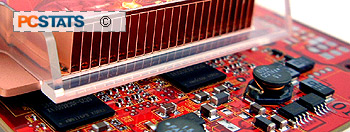Things are getting interesting in the video
card market once again, mainly because of the ATIs new 'Crossfire'
dual-videocard feature. It's hoped that Crossfire will give the Canadian company
the means to better compete against nVidia on the SLI technological front, resulting in better toys for us
all!
In the mean time, ATI still holds quite an edge in the (single) high-end videocard
arena with its range of X800/X850 graphics cards. We've had the pleasure of
testing several products based on these GPUs, and found them to be excellent performers all
around..
Today, PCstats will
take a look at one of MSI's latest ATI-based cards, the PCI-Express based RX800XL-VT2D256E. Catchy
name.
The MSI RX800XL-VT2D256E uses the ATI Radeon X800XL core and is backed by
256MB of speedy Samsung GDDR 3 2ns memory. The most notable
feature of the card is its dual-DVI connectors, but it also sports a full
complement of multimedia abilities including VIVO, and HDTV-out as well as
a nice software bundle.
 Running dual monitors has gained a lot of
popularity these last few years but only recently have videocard
manufacturers started equipping videocards with dual DVI outputs.
Sure there have been one or two videocards released that support this feature, but the
vast majority of videocards come with analog only or analog/DVI outputs. This puts users with two digital
LCDs in a bit of a bind since an analog image is not
as sharp or crisp as digital. With two DVI connectors and two DVI-to-analog converters, the
RX800XL-VT2D256E is the perfect videocard for those who want to use dual LCD monitors,
or an LCD and a CRT.
Running dual monitors has gained a lot of
popularity these last few years but only recently have videocard
manufacturers started equipping videocards with dual DVI outputs.
Sure there have been one or two videocards released that support this feature, but the
vast majority of videocards come with analog only or analog/DVI outputs. This puts users with two digital
LCDs in a bit of a bind since an analog image is not
as sharp or crisp as digital. With two DVI connectors and two DVI-to-analog converters, the
RX800XL-VT2D256E is the perfect videocard for those who want to use dual LCD monitors,
or an LCD and a CRT.
 Unfortunately, MSI saw fit
to include only a single DVI-to-analog converter, meaning that dual-monitor fans with two CRTs need
not apply. This seems to be a bone headed decision, since the company has otherwise equipped
the RX800XL-VT2D256E with excellent accessories.
Unfortunately, MSI saw fit
to include only a single DVI-to-analog converter, meaning that dual-monitor fans with two CRTs need
not apply. This seems to be a bone headed decision, since the company has otherwise equipped
the RX800XL-VT2D256E with excellent accessories.
MSI uses a fairly typical active heatsink to cool the RX800XL-VT2D256E's core.
The fan is speed throttled and was inaudible when we were running the 2D desktop, but quite
audible when running benchmarks. It's not something that's going to
scream at you across the room, or even be audible inside a typical computer
case, but we have heard quieter coolers recently. The Samsung memory chips do not use any form of heatsink.

